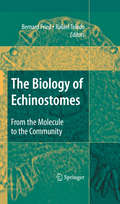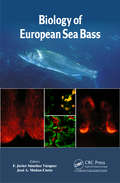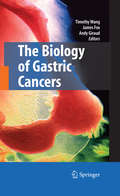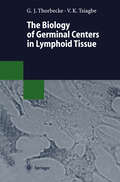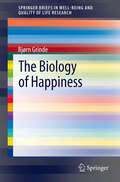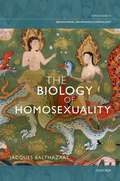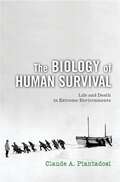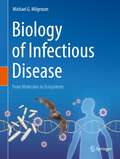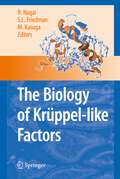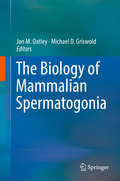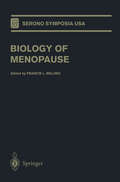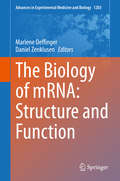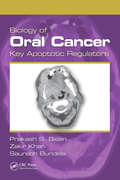- Table View
- List View
The Biology of Echinostomes: From the Molecule to the Community (Biomathematics Ser. #Vol. 9)
by Rafael Toledo Bernard FriedEchinostomes are medically- and veterinary-important parasitic flatworms that invade humans, domestic animals and wildlife and also parasitize in their larval stages numerous invertebrate and cold-blooded vertebrate hosts. The interest in echinostomes in parasitology and general biology comes from several areas: (1) Human infections; (2) Experimental models; (3) Animal infections; (4) Systematics. The application of novel techniques is moving the echinostomes to the frontline of parasitology in fields such as systematics, immunobiology in vertebrate and invertebrate organisms and proteomics among others. The Biology of Echinostomes demonstrates the application of new techniques to a group of trematodes that may serve to obtain information of great value in parasitology and general biology. The book includes basic topics, such as biology and systematics, as well as more novel topics, such as immunobiology, proteomics, and genomics of echinostomes. The authors of each chapter emphasize their content with: (i) the most novel information obtained; (ii) analysis of this information in a more general context (i.e. general parasitology); and (iii) future perspectives in view of the information presented. The subjects are analyzed from a modern point of view, considering aspects such as applications of novel techniques and an analysis of host-parasite interactions.
Biology of Endothelial Cells (Developments in Cardiovascular Medicine #27)
by Eric A. JaffeThe participation of endothelial cells in various physiologic and pathologic processes has been hypothesized since before the turn of the century. However, until recently, direct evidence for endothelial involvement in these processes has been extremely difficult to obtain due to the inability to study endothelial cell function in vitro. Though the possibility of using cultured endothelial cells to study endothelial cell function in vitro was recognized many years ago, the inability to culture unambiguously identifiable endothelial cells limited investigators in their studies of endothelial function. As a result, the field of endothelial cell biology lay relatively fallow for many years. The development in the early 1970's of routine and easily implemented methods for culturing human endothelial cells and the demonstration that cultured endothelial cells synthesized a physiologically relevant protein, Factor VIII/von Willebrand Factor, quickly changed this state of affairs. Over the following decade the scope of endothelial cell research rapidly widened, spreading in a number of directions. First, methods were developed to culture endothelial cells from a variety of species. Second, methods were developed to culture endothelial cells from different organs and types of blood vessels (arteries, veins, and capillaries) within a single species. Third, and most important, investigators began using cultured endothelial cells as tools to study the potential involvement of endothelial cells in a wide assortment of biologically interesting processes. The net result has been a tremendous increase in our understanding of endothelial cell function.
Biology of European Sea Bass
by F. Javier Sánchez Vázquez José A. Muñoz-CuetoBiology of European Seabass presents up-to-date reviews on key topics of seabass biology, written by leading scientific experts with extensive knowledge of seabass as well as their respective field of expertise. The book covers the biology and ecology of the different sea basses and the latest findings in molecular biology, physiology, and beh
The Biology of Gastric Cancers
by James G. Fox Timothy C. Wang Andrew S. GiraudAs someone who has spent nearly half his life wondering about the relationship between Helicobacter and gastric cancer, I find this textbook on the subject exciting and timely. In fact, I am not aware of any other volume that has been able to distil so much new knowledge into such a comprehensive account of a poorly understood field. Taking my own view, as a scientist placed in the middle of the spectrum between basic science and clinical medicine, I can see that the editors, Jim Fox, Andy Giraud, and Timothy Wang, provide a broad mix of expertise, which ensures that the subject is treated with the right balance. From clinicopathologic observations in humans, to epidemiology, through animal models, to molecular and cell biology, this team has hit the mark for most readers. Fox is a well-known leader in animal models with broad expertise. He pioneered the field with observations on Helicobacter species in animals, from the time when only one spiral gastric bac- rium was known, “Campylobacter pyloridis. ” Fox partners with Wang, whose team recently announced a dramatic advance in the field of carcinogenesis—the obser- tion that bone marrow–derived stem cells participate in the changes that become cancer. To this nice mix has been added Andy Giraud from my own country, who brings to the table some remarkable genetic models of gastric cancer based on alterations in the gp130/stat3-signaling pathway.
The Biology of Germinal Centers in Lymphoid Tissue
by G. Jeanette Thorbecke Vincent K. TsiagbeThis book meets the demand of a recent surge of interest in germinal centers, the foci of antigen-induced, rapidly proliferating B lymphocytes, representing sites in mammalian lymphoid tissue where memory B cells are generated. Various aspects of the generation of germinal centers, the somatic hypermutation process and the cellular interactions involved in the selection process are discussed in detail. A chapter on germinal center-derived lymphomas completes the treatment.
The Biology of Glial Cells: Recent Advances
by Ishan Patro Pankaj Seth Nisha Patro Prakash Narain TandonThis book reviews the role of glial cells (astrocytes, microglia, oligodendroglia, satellite cells, and Schwann cells) in neuronal health and diseases. It discusses the latest advances in understanding their origin, differentiation, and hemostasis. The book also examines the role of microglial cells in central nervous system (CNS) development, maintenance, and synaptic plasticity. Further, the book presents the functions of astrocytes in healthy CNS and their critical role in CNS disorders, including Parkinson's and Alzheimer's diseases. Notably, the book describes the pathobiology, molecular pathogenesis, stem cells, and imaging characteristics of gliomas. It defines the role of glial cells in regulating iron homeostasis and their effect on the neurodegeneration of neurons. Lastly, it covers the structure, function, and pathology of oligodendrocytes and their role in neuronal health and disease.
The Biology of Glycoproteins
by Raymond IvattThis book is in many ways a sequel to The Biochemistry ojGlycoproteins and Proteoglycans. The enormous recent progress in understanding the biological roles of glycoproteins has prompted the present volume. The reasons for studying glycoproteins have multiplied, and in the present volume the roles played by glycoproteins are explored in a variety of biological situations. The first two chapters describe molecules involved in cell-substratum and cell-cell interactions in a broad sense, and also focus on recent progress in identifying specific attachment molecules. Our understanding of how normal processes, such as cellular differentiation and tissue organization, are regulated is dependent on understanding how cells interact with the extracellular matrix. When these processes go awry the consequences can be tragic, for example, when manifest as birth de fects and cancer. Our ability to devise appropriate therapies is in many cases limited by our understanding of such cell-matrix interactions. The third chapter explores the roles by glycoproteins during early mammalian development. The carbohydrate portions c1early play very important roles in presenting information during early embryogenesis, and an unusual tumor stern cell, the embryonal carcinoma, looks very promising in pro viding an experimental system for understanding how the expression of these complex carbohydrate determinants is regulated. The next three chapters explore the biology of glycoproteins in distinct situations: in the immune system, in the nervous system, and during erythropoiesis.
The Biology of Happiness (SpringerBriefs in Well-Being and Quality of Life Research)
by Bjørn GrindeThe brief presents a model for happiness based on current knowledge in evolutionary biology and neurobiology. Briefly, the primary purpose of nervous systems is to direct an animal toward behaviour relevant for survival and procreation. In primitive animals actions are based on reflexes, while in humans the modules directing behaviour engage positive and negative affect (good and bad feelings), and they are swayed by cognitive processes. The reason why evolution opted for this strategy was the improved flexibility in response – i.e., we learn from previous experiences. The human capacity for happiness is an accidental consequence.An array of brain modules has evolved to care for various pursuits, but recent studies suggest that they converge on shared neural circuits designed to generate positive and negative mood. Happiness can be construed as the net output of the relevant modules. The briefs suggests a strategy for how to avoid having negative feelings (such as anxiety, depression and chronic pain) dominate the mind, and how to exercise positive feelings. In short, the book offers both a deeper understanding of what happiness is about, and a framework for improving well-being.An array of brain modules has evolved to care for various pursuits, but recent studies suggest that they converge on shared neural circuits designed to generate positive and negative mood. Happiness can be construed as the net output of the relevant modules. The book suggests a strategy for how to avoid having negative feelings (such as anxiety, depression and chronic pain) dominate the mind, and how to exercise positive feelings. In short, the book offers both a deeper understanding of what happiness is about, and a framework for improving well-being.
The Biology of Homosexuality (Oxford Series in Behavioral Neuroendocrinology)
by Jacques BalthazartIn this fascinating book, Jacques Balthazart presents a simple description of the biological mechanisms that are involved in the determination of sexual orientation in animals and also presumably in humans. Using scientific studies published over the last few decades, he argues that sexual orientation, both homosexual and heterosexual, is under the control of embryonic endocrine and genetic phenomena in which there is little room for individual choice. The author begins with animal studies of the hormonal and neural mechanisms that control the so-called instinctive behaviors and analyzes how this animal work may potentially apply to humans. The book does not focus exclusively on homosexuality, however. Instead, the book acts as a broader guide to the biological basis of sexual orientation, and also discusses important gender differences that may influence sexual orientation. While firmly grounded in the scientific literature, this text is developed for a broader audience and will be of interest to psychologists, researchers, students, and anyone interested in the biological factors that determine our sexuality.
The Biology of Homosexuality (Oxford Series in Behavioral Neuroendocrinology)
by Jacques BalthazartIn this fascinating book, Jacques Balthazart presents a simple description of the biological mechanisms that are involved in the determination of sexual orientation in animals and also presumably in humans. Using scientific studies published over the last few decades, he argues that sexual orientation, both homosexual and heterosexual, is under the control of embryonic endocrine and genetic phenomena in which there is little room for individual choice. The author begins with animal studies of the hormonal and neural mechanisms that control the so-called instinctive behaviors and analyzes how this animal work may potentially apply to humans. The book does not focus exclusively on homosexuality, however. Instead, the book acts as a broader guide to the biological basis of sexual orientation, and also discusses important gender differences that may influence sexual orientation. While firmly grounded in the scientific literature, this text is developed for a broader audience and will be of interest to psychologists, researchers, students, and anyone interested in the biological factors that determine our sexuality.
The Biology of Human Longevity: Inflammation, Nutrition, and Aging in the Evolution of Lifespans
by Caleb E. FinchWritten by Caleb Finch, one of the leading scientists of our time, The Biology of Human Longevity: Inflammation, Nutrition, and Aging in the Evolution of Lifespans synthesizes several decades of top research on the topic of human aging and longevity particularly on the recent theories of inflammation and its effects on human health. The book expands a number of existing major theories, including the Barker theory of fetal origins of adult disease to consider the role of inflammation and Harmon's free radical theory of aging to include inflammatory damage. Future increases in lifespan are challenged by the obesity epidemic and spreading global infections which may reverse the gains made in lowering inflammatory exposure. This timely and topical book will be of interest to anyone studying aging from any scientific angle.Author Caleb Finch is a highly influential and respected scientist, ranked in the top half of the 1% most cited scientistsProvides a novel synthesis of existing ideas about the biology of longevity and agingIncorporates important research findings from several disciplines, including Gerontology, Genomics, Neuroscience, Immunology, Nutrition
The Biology of Human Survival: Life and Death in Extreme Environments
by Claude A. PiantadosiThe range of environments in which people can survive is extensive, yet most of the natural world cannot support human life. The Biology of Human Survival identifies the key determinants of life or death in extreme environments from a physiologist's perspective, integrating modern concepts of stress, tolerance, and adaptation into explanations of life under Nature's most austere conditions. The book examines how individuals survive when faced with extremes of immersion, heat, cold or altitude, emphasizing the body's recognition of stress and the brain's role in optimizing physiological function in order to provide time to escape or to adapt. In illustrating how human biology adapts to extremes, the book also explains how we learn to cope by blending behavior and biology, first by trial and error, then by rigorous scientific observation, and finally by technological innovation. The book describes life-support technology and how it enables humans to enter once unendurable realm, from the depths of the ocean to the upper reaches of the atmosphere and beyond. Finally, it explores the role that advanced technology might play in special environments of the future, such as long journeys into space.
The Biology of Idiotypes
by Mark GreeneThe phenomenon of idiotypy was discovered almost thirty years ago, but it was only during the past decade that it attracted widespread interest and became the subject of numerous research investigations. From the outset, much of the interest in idiotypy was based on its implications with respect to the repertoire of antibodies. Kunkel showed, for example, that idiotypes associated with certain human myeloma or Bence-Jones proteins were present in normal human globulins at levels of less than one part per million. Also, Oudin's original definition of idiotypy implied that idiotypes could be uniquely associated with individual rabbits as well as with particular antigen-binding specificities. Such observations provided some of the earliest evidence for an extensive repertoire of immunoglobulin molecules. The implications of these findings have been amply confirmed by recent studies of protein struc ture and molecular genetics; many of these studies are reviewed in the present volume. It is known now that the diversity of antibodies is based on the presence of numerous V and L V H genes, on recombinatorial events involving D and] segments, on somatic mutations, and on processes involving deletion of DNA followed by repair with errors, including inser tions. Each of these parameters is capable of influencing the idiotype expressed by the final immunoglobulin product. Regulation of the immune response is another area in which idiotypy has significantly influenced modern immunology.
Biology of IGF-1: Its Interaction with Insulin in Health and Malignant States (Novartis Foundation Symposia #262)
by Novartis Foundation Novartis Foundation Symposium Staff Gregory R. Bock Jamie A. GoodeAn invaluable book containing a series of interdisciplinary discussions between clinical and basic scientists. Biology of IGF-1: Its interaction with insulin and health and malignant states focuses on key issues such as: the definition of danger zones the development of methods for early recognition of malignant states linked to IGF-1 and/or insulin possible approaches to preventative intervention the relevance in this field of research to the development of novel therapeutic approaches to treating certain cancers.
Biology of Infectious Disease: From Molecules to Ecosystems
by Michael G. MilgroomThis textbook provides a broad introduction to the biological processes underlying infectious diseases in a range of hosts and pathogens. The text covers topics at all levels of biological organization, from the molecular and cellular level, organismal level, and population and ecosystem level, and goes well beyond infectious diseases of humans. The details of how microbes interact with their hosts are unique for each interaction, but emphasis is on the common principles of host-pathogen interactions that result in disease. Biology of Infectious Disease: From Molecules to Ecosystems is aimed at undergraduate and early graduate-level students in biology or public health, including pre-medical and pre-public-health students, who are interested in a broad introduction to infectious disease but do not have any previous background in microbiology or immunology.
The Biology of Krüppel-like Factors
by Ryozo Nagai Scott L. Friedman Masato KasugaKruppel-like factors (KLFs) are attracting great attention across a wide spectrum of biological sciences and medicine because of their remarkable biological potency and the diversity of roles they play in the physiological and pathological changes of cells and tissues. This book is a comprehensive compendium of the latest research on the molecular mechanisms of KLFs, describing their roles in transcriptional regulation, cellular differentiation and development, the pathogenesis of the liver and cardiovascular systems and cancer, and generation of ES cells and iPS cells. As the only concise treatise written to date by leading experts in the field, it serves as an authoritative review of this family of molecules and is an essential reference for all who are interested in KLFs. The book also explores the potential of KLFs as targets for novel therapeutics and diagnostics, and will be invaluable in those fields.
The Biology of Learning: Report of the Dahlem Workshop on the Biology of Learning Berlin, 1983, October 23–28 (Dahlem Workshop Report #29)
by P. C. Holland D. E. Kroodsma J. C. Marshall R. Menzel J. MortonP. Marler* and H. S. Terrace** *The Rockefeller University Field Research Center Millbrook, NY 12545 **Dept. of Psychology, Columbia University New York, NY 10027, USA For the first half of this century, theories of animal conditioning were regarded as the most promising approach to the study of learning - both animal and human. For a variety of reasons, disillusionment with this point of view has become widespread during recent years. One prominent source of disenchantment with conditioning theory is a large body of ethological observations of both learned and unlearned natural behavior. These challenge the generality of principles of animal learning as derived from the intensive study of a few species in specialized laboratory situations. From another direction, the complexities of human language acquisition, surely the most impressive of learned achievements, have prompted developmental psychologists to doubt the relevance of principles of animal learning. Even within the realm of traditional studies of animal learning, it has become apparent that no single set of currently available principles can cope with the myriad of new empirical findings. These are emerging at an accelerating rate from studies of such phenomena as selective attention and learning, conditioned food aversion, complex problem solving behavior, and the nature of reinforcement. Not very surprisingly, as a reaction against the long-held but essentially unrealized promise of general theories of learning, many psychologists have asked an obvious question: does learning theory have a future? 2 r. Marler and B. S.
The Biology of Mammalian Spermatogonia
by Jon M. Oatley Michael D. GriswoldThis book provides a resource of current understandings about various aspects of the biology of spermatogonia in mammals. Considering that covering the entire gamut of all things spermatogonia is a difficult task, specific topics were selected to provide foundational information that will be useful for seasoned researchers in the field of germ cell biology as well as investigators entering the area. Looking to the future, the editors predict that the foundational information provided in this book -- combined with the advent of new tools and budding interests in use of non-rodent mammalian models -- will produce another major advance in knowledge regarding the biology of spermatogonia over the next decade. In particular, we anticipate that the core molecular machinery driving different spermatogonial states in most, if not all, mammals will be described fully, the extrinsic signals emanating from somatic support cell populations to influence spermatogonial functions will become fully known, and the capacity to derive long-term cultures of SSCs and transplant the population to regenerate spermatogenesis and fertility will become a reality for higher order mammals.
Biology of Menopause (Serono Symposia USA)
by Francis L. BellinoBiology of Menopause presents the proceedings of an international symposium held from September 10-13, 1998 in Newport Beach, CA. The proceedings review current knowledge and explores future research directions on the biologic changes of the hypothalamic-pituitary-ovarian axis across the menopausal transition and the associated changes in physiologic systems outside of the HPO axis, including the brain, the musculoskeletal and cardiovascular systems. Additionally, chapters present new methods of study and emerging areas of research.
The Biology of mRNA: Structure and Function (Advances in Experimental Medicine and Biology #1203)
by Marlene Oeffinger Daniel ZenklusenThe book provides an overview on the different aspects of gene regulation from an mRNA centric viewpoint, including how mRNA is assembled and self-assembles in a complex consisting of RNA and proteins, and how its ability to be translated at the right time and space depends on many processes acting on the mRNAs, leading to a properly folded complex. This book shows how new technologies have led to a better understanding of these processes and their connected diseases.The book is written for scientists in fundamental and applied biomedical research working on different aspects of gene regulation. It is also targeted to an audience that is not implicated in these fields directly, but wants to gain a better understanding of mRNA biology.
Biology of Negative Strand RNA Viruses: The Power of Reverse Genetics (Current Topics in Microbiology and Immunology #283)
by Yoshihiro KawaokaNegative-strand RNA viruses, so named because of the polarity of their genomic RNA to mRNA, include important human and non-human pathogens. This volume covers major advances in reverse genetics techniques over the past decade, state-of-the-art basic science and the clinical implications of experimental findings. This should rekindle interest in negative-strand RNA viruses among readers, including those in other disciplines, leading to further progress in understanding these important viruses and in developing effective measures of control.
The Biology of Neuropeptide Y and Related Peptides (Contemporary Neuroscience)
by William F. Colmers Claes WahlestedtLeading experts critically summarize the state of knowledge concerning the molecular, anatomical, physiological, and behavioral aspects of NPY and its congeners. Each article provides a comprehensive and in-depth survey, an overview of the role of NPY in the discipline covered, a discussion of the likely future direction that the field will take, and an up-to-date bibliography. Chapters include a treatment of the evolution of the PP family of genes, the structure of the NPY gene, and the distribution of NPY on the cardiovascular system, actions of NPY on the electrophysiological properties of nerve cells, and the effects of NPY on feeding and behavior. The chapters are written in an accessible style and serve both as an introduction to the field and as an extensive and detailed treatment of the current state of knowledge.
The Biology of Nicotine Dependence (Novartis Foundation Symposia #152)
by Gregory R. Bock Joan MarshNicotine is considered to be the main agent in the maintenance of the tobacco smoking habit and is largely responsible for the behavioral and physiological responses to the inhalation of tobacco smoke. This work presents advances made in the elucidation of the action of nicotine in the body--essential information for developing treatments to help people give up smoking. The book reviews the progress made in identifying nicotinic acetylcholine receptors in the brain, using the techniques of molecular biology to characterize receptors and investigate the functional differences between receptors composed of different types of subunits. Sex-specific differences in the response to nicotine, the effects of nicotine on locomotor activity, and its still-debated influence on cognitive performance are considered. The book also examines the habit-forming role of nicotine, the development of tolerance to nicotine, and the less clearly understood phenomenon of withdrawal. Also discusses some potential therapeutic strategies.
Biology of Oral Cancer: Key Apoptotic Regulators
by Prakash S. Bisen Zakir Khan Saurabh BundelaDespite a decline in developed countries, cancer has consistently maintained its status as one of the top killers since time immemorial. Exploring cancer management and treatment at the molecular level, Biology of Oral Cancer: Key Apoptotic Regulators presents a key molecular event-apoptosis-in relation to genesis and progression of oral cancer. Th
Biology of Orthodontic Tooth Movement: Current Concepts and Applications in Orthodontic Practice
by Bhavna ShroffThis book presents the current knowledge and understanding of the biological processes involved in the orthodontic movement of teeth and discusses recent progress in the field. It links research advances to their immediate clinical applications and offers researchers and clinicians a state of the art reference on topical issues relating to orthodontic tooth movement. Biological events play a central role in the movement of teeth during orthodontic therapy. The basis for understanding the sequence of cellular events that leads to orthodontic movement has been well established in the literature through the use of animal models. In recent years, researchers and clinicians have focused their efforts on developing treatment modalities to increase the speed of orthodontic treatment and provide better anchorage options for noncompliant patients. This book will be an invaluable aid in understanding the biology of tooth movement and the relevance of the latest concepts to clinical practice.
